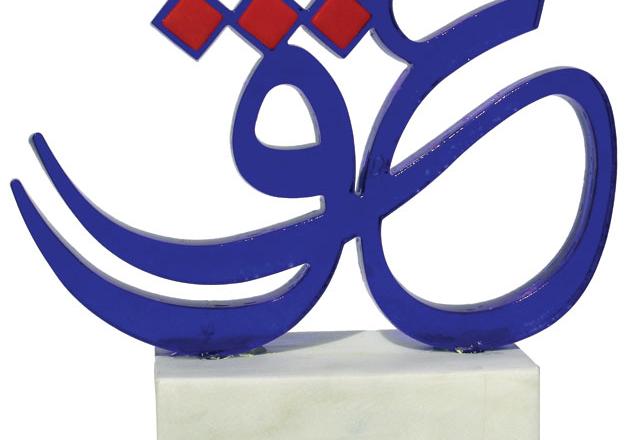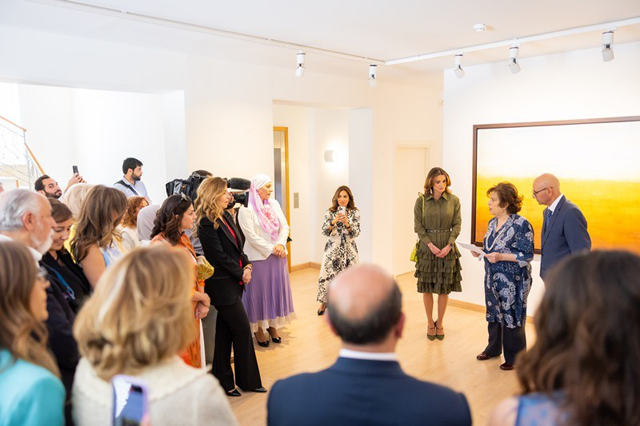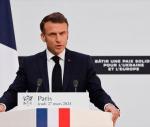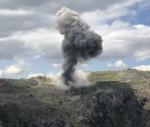You are here
Playfulness and artistry
By Ica Wahbeh - Mar 01,2015 - Last updated at Mar 01,2015

AMMAN — A feel-good sensation embraces the viewer of the works exhibited by Wijdan at the Jordan National Gallery of Fine Arts even before the senses grasp their meaning.
It is the playfulness and artistry of the aesthetically pleasing silhouettes detaching themselves against the white walls and the vivid, attractive colours which seem to emanate light that draw the eye first.
Then, one reads the words these sculptural representations spell out in delightful calligraphy, repeatedly, like a mantra: variations of the word love in Arabic — hob, walah, ishq, wajd, wasl (connection that brings lovers together).
Moving around to take in the details is like repeating a chant, a spiritual incantation that charms souls. It is a spiritual journey of sorts, and one cannot but fall in love with what one sees.
“The sculptures executed in Italian Murano glass denote the word ‘love’ and its synonyms, a concept I have been including in my art for over a decade and a half. Love, in all its forms and connotations, remains the major and foremost concept of my art works,” says the artist.
The glass, sheets of different colours stuck together in ovens, is cut by the use of water to create unexpected art forms with a message.
Whether made of one letter, like the powerful “lamalef” — one letter made of two that starts the “shahada” in Islam, negating but immediately asserting (la illaha illallah) — one word, invariably a variation of “love”, or several words connected, the lettering, in a stunning range of colours, forms spatial representations that soar like flames or crouch like an animal ready to pounce.
They are figurative yet abstract, symmetrical — at times truly mirror images that gracefully combine to form attractive figures — or artistically asymmetrical, and at all times a source of wonder and delight.
Their surfaces both absorb and reflect light, they are both transparent and opaque; although glass, they have a glowing warmth and are sensual, inviting a surreptitious stroke. And why shouldn’t they when they spell out the meaning they do?
The white Carrara marble base enhances their pristine nature. It is the vibrancy of the colours in which they are executed that suggests love and exuberance, while also making one marvel at human ingenuity.
Interspersed among the sculptures, and skilfully grouped by colour and theme, are several paintings on a wide array of paper from different countries of the world.
The title of the exhibition, “Transparencies: Paper and glass”, could not have been more aptly chosen.
For, although paper does not normally strike one as a transparent medium, in Wijdan’s case, it often is.
Layer upon layer of colourful sheets, stripes, bands, ribbons, frayed fibre and parchment-like panes are often brought together, in collages, to create geometric patterns, movement and depth.
Different textures are superimposed, leaving one guessing at all times.
One constant are the spiritual words that appear here and there — hua, meaning God, anta, ana, the self — in beautiful calligraphy.
“Certain Arabic words and letters that have bonds to Sufi idioms also occupy a part of my layered paper compositions,” says the artist.
The lotus flower, implying meditation, the ribbons that “villagers and mendicants, after making a wish, tie on a tree near Sufi shrines of holy men and women, in the hope their wish would come true”, the peepal leaf, “mentioned in Buddhist manuscripts as the first tree to be created on Earth”, delicate and a work of art in itself, and tiny glittering trinkets used to adorn Indian brides make their way in Wijdan’s paintings, enhancing the symbolism and strengthening the mysticism.
The layering does not seem to end. Layers of papers, ribbons, leaves and paint create almost three-dimensional works that are supported by a white background and surrounded by white wooden frames that delineate them on the white walls, frame within frame, within a wider frame: a very ingenious placement.
The juxtaposition of paintings and sculptural works is carefully chosen; the groupings create clusters of peace and oases of love of stunning visual impact.
Love, spirituality and contentment are the overriding feelings elicited by these works that Wijdan wishes to see the young generation access and appreciate.
And what a difference that would make in these times!
The works are on display until March 21.
Related Articles
AMMAN — Her Majesty Queen Rania inaugurated the Wijdan Art Space building at the Jordan National Gallery of Fine Arts (JNGFA) Park in Jabal
AMMAN — An exhibition titled “Euphrosyne” has used the mediums of pottery and painting to portray a variety of euphoric experiences at Amman
AMMAN — Under the patronage of HRH Princess Wijdan Al Hashemi, the retrospective exhibition of the artist Nabila Hilmi opened at the Jordan



















